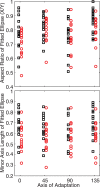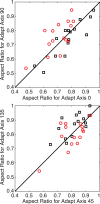Individual and age-related variation in chromatic contrast adaptation
- PMID: 22904356
- PMCID: PMC3444168
- DOI: 10.1167/12.8.11
Individual and age-related variation in chromatic contrast adaptation
Abstract
Precortical color channels are tuned primarily to the LvsM (stimulation of L and M cones varied, but S cone stimulation held constant) or SvsLM (stimulation of S cones varied, but L and M cone stimulation held constant) cone-opponent (cardinal) axes, but appear elaborated in the cortex to form higher-order mechanisms tuned to both cardinal and intermediate directions. One source of evidence for these higher-order mechanisms has been the selectivity of color contrast adaptation for noncardinal directions, yet the degree of this selectivity has varied widely across the small sample of observers tested in previous studies. This study explored the possible bases for this variation, and in particular tested whether it reflected age-related changes in the distribution or tuning of color mechanisms. Observers included 15 younger (18-22 years of age) and 15 older individuals (66-82), who adapted to temporal modulations along one of four chromatic axes (two cardinal and two intermediate axes) and then matched the hue and contrast of test stimuli lying along eight different directions in the equiluminant plane. All observers exhibited aftereffects that were selective for both the cardinal and intermediate directions, although selectivity was weaker for the intermediate axes. The degree of selectivity increased with the magnitude of adaptation for all axes, and thus adaptation strength alone may account for much of the variance in selectivity among observers. Older observers showed a stronger magnitude of adaptation thus, surprisingly, more conspicuous evidence for higher-order mechanisms. For both age groups the aftereffects were well predicted by response changes in chromatic channels with linear spectral sensitivities, and there was no evidence for weakened channel tuning with aging. The results suggest that higher-order mechanisms may become more exposed in observers or conditions in which the strength of adaptation is greater, and that both chromatic contrast adaptation and the cortical color coding it reflects remain largely intact in the aging visual system.
Figures









References
-
- Anstis S., Cavanagh P. (1983). A minimum motion technique for judging equiluminance. In Mollon J. D., Sharpe L. T.(Eds.), Color vision. (pp 155–166). London: Academic.
-
- Baker C. L., Mareschal I. (2001). Processing of second-order stimuli in the visual cortex. Progressive Brain Research , 134, 171–191. - PubMed
-
- Belmore S. C., Shevell S. K. (2008). Very-long-term chromatic adaptation: Test of gain theory and a new method. Visual Neuroscience , 25(3), 411–414. - PubMed
-
- Betts L. R., Sekular A. B., Bennett P. J. (2007). The effects of aging on orientation discrimination. Vision Research, 47, 1769–1780. - PubMed
-
- Billino J., Bremmer F., Gegenfurtner K. R. (2008). Differential aging of motion processing mechanisms: Evidence against general perceptual decline. Vision Research, 48, 1254–1261. - PubMed
Publication types
MeSH terms
Grants and funding
LinkOut - more resources
Full Text Sources

